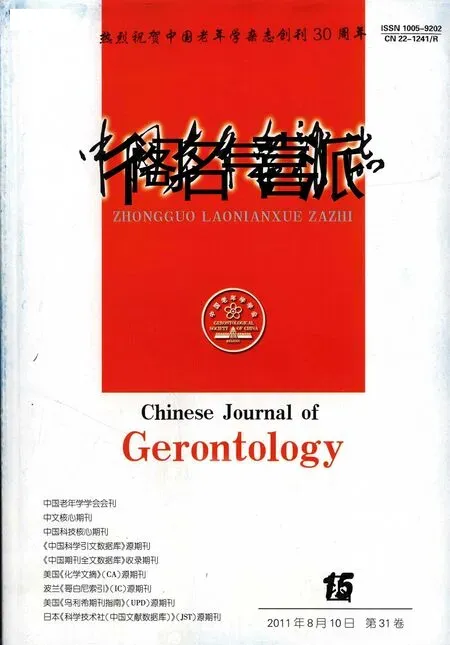胃黏膜的增龄性变化研究进展
殷于磊 卢 晨 余 波 杜 杰 肖 立 郑松柏 (复旦大学附属华东医院,上海 200040)
胃黏膜由上皮、固有层、黏膜肌层构成,含有贲门腺、胃底腺和幽门腺三种管状外分泌腺体。在人体生长发育成熟后,胃黏膜随增龄而发生老化,了解胃黏膜老化的特点对正确认识老年人上消化道疾病具有重要意义。
1 胃黏膜形态的增龄性变化
关于胃黏膜形态的增龄性改变曾有许多动物实验研究,Majumdar等〔1〕发现,24月龄的大鼠较4月龄鼠的胃黏膜厚度高,但腺体高度降低32%,腺体密度也下降(腺体个数/cm3),且排列紊乱,腺腔大小不一,部分呈囊性扩张,上皮细胞分泌功能降低,体积变小,胞质内分泌空泡消失,黏膜固有层和黏膜肌层结缔组织大量增生伴有胶原化;Hollander等〔2〕在大鼠中也观察到类似的现象;日本学者发现老年小鼠胃窦腺周围血管的基底膜增宽〔3〕;Hollander等认为,固有层胶原组织增生是胃黏膜老化的基本病理改变,因为这些胶原化增厚的结缔组织将上皮细胞与滋养脉管分隔开,影响氧及营养物质的扩散,从而导致腺体萎缩性变化和分泌功能降低,所以老化的胃黏膜厚度虽然增加,但腺体却是萎缩的。
人体胃的增龄性改变曾被描述为萎缩性的,文献报道老年人的萎缩性胃炎发病率增加,在80岁以上人群中发病率达50% ~70%〔4,5〕。但是,胃幽门螺杆菌(Hp)慢性感染的发现使人们对此产生了疑问。在人群中,Hp感染率随着年龄的增长而增高。据调查,有胃十二指肠疾病的老年人群中感染率超过70%,无症状的老年人群中约40% ~60%有Hp感染〔6〕。日本学者曾开展了一系列研究,主要针对Hp感染的长期效应和它在胃的老年性改变(如萎缩、肠化)中所起的作用。一项大型的多中心研究发现,是Hp感染而非增龄本身引起萎缩性胃炎和肠化〔7〕。但是,在Hp阳性个体中,萎缩和肠化随年龄增长而增加〔8〕。另两个前瞻性研究发现Hp阳性病人中萎缩性胃炎、肠化和异型增生的发生率增加,因此认为Hp慢性感染是预测胃萎缩发生的主要因素〔9,10〕。另外,据 Kokkola报道,通过对有Hp感染的老年萎缩性胃炎病人的前瞻性随访,发现在根除Hp感染后,萎缩、肠化及炎症均显著好转〔11〕。
2 胃泌酸功能的增龄性改变
1920年~1980年,曾多项研究报道认为老年人胃酸分泌大幅下降,但Hp的发现,使增龄、Hp、胃黏膜萎缩以及胃酸分泌功能之间的关系变得更为复杂。近来20年来的许多研究表明,泌酸功能没有随年龄增高改变,甚至有些报告认为老年人胃酸分泌是增加的。日本学者发现在Hp阴性个体中,增龄对于胃酸分泌没有影响,在Hp阳性个体中,胃酸分泌随年龄增加而减少〔12〕。Lijima发现,老年人胃酸分泌功能没有减退,相反,在Hp阴性的个体中反而有上升现象〔13〕。
Hp感染造成泌酸减少有两个原因:(1)胃体的萎缩性胃炎,(2)释放的炎性介质(IL-1β和TNF-α)会抑制壁细胞泌酸。另外刘懿等〔14〕对Hp阳性胃炎患者杀菌治疗前后胃壁细胞超微形态及质子泵(H+-K+ATP酶)mRNA基因表达情况的研究发现,Hp感染患者胃黏膜壁细胞分泌活性明显降低。根除Hp感染后胃黏膜壁细胞形态及泌酸功能均得以恢复。H+-K+ATP酶RNA的基因表达较治疗前升高,从而认为Hp通过下调壁细胞H-K ATP酶亚基的mRNA基因表达,而使得胃酸分泌减少。
壁细胞是泌酸细胞,它通过壁细胞顶部分泌小管膜上质子泵(即H+-K+ATP酶)的质子转运而实现其泌酸功能,H+-K+ATP酶由催化α亚单位和糖基化β亚单位构成。α亚单位通过水解ATP为离子跨膜转运提供能量,β亚单位则主要负责全酶的装配。壁细胞受刺激分泌胃酸有两条细胞内通路,一条是细胞内钙离子增加,另一条通过组胺使细胞内CAMP增加。Setsuko等发现老龄大鼠的H+-K+ATP酶蛋白表达减少,并且CAMP通路可能更易受到衰老的影响〔15〕。目前此方面报道不多。
另外,与胃酸密切相关的是胃蛋白酶,可能由于其在胃液中不稳定,难以研究,这方面报道不多。Feldman曾报道老年人胃内胃蛋白酶含量降低〔16〕。
3 胃黏膜防御机制的增龄性改变
正常时,黏液细胞可分泌大量黏液,形成一松软的凝胶层,覆盖于黏膜表面,黏液细胞分泌的HCO-3也渗入到此凝胶层中,形成一层“黏液-碳酸氢盐屏障”,此屏障加上胃黏膜表面的一层磷脂,共同构成疏水性屏障,保护胃黏膜免受食物的摩擦损伤,并阻止胃黏膜细胞与高浓度的酸及胃蛋白酶直接接触。另外,胃上皮细胞的顶端膜及细胞之间存在紧密连接,可阻止H+进入黏膜层内。紧密连接与黏液-碳酸氢盐-磷脂屏障共同构成胃黏膜屏障。其次胃黏膜能合成大量的前列腺素(PG),它们可抑制胃酸、胃蛋白酶原的分泌,刺激黏液和碳酸氢盐分泌,扩张黏膜下血管,增加血流,有助于维持胃黏膜的完整性和促进受损胃黏膜的修复。此外,胃黏膜上皮是不断更新的,这又给胃黏膜提供了进一步的保护。正常情况下,黏膜的保护性因素与损伤性因素如胃酸、胃蛋白酶、Hp、非甾体类抗炎药(NSAID)等处于平衡状态,平衡被打破时将出现糜烂、溃疡等病变。
3.1 黏液-碳酸氢盐-磷脂屏障 黏液-碳酸氢盐-磷脂屏障是胃黏膜的第一道屏障,Farinati〔6〕等研究正常人的胃镜下活检标本,发现随着年龄增加,胃体壁细胞数量增加,黏液细胞减少,壁细胞/黏液细胞比值逐渐上升〔17〕。Newton等发现老年人胃及十二指肠黏液层变薄〔18,19〕。还有学者发现随年龄增长,黏液的性质有所改变,且与Hp感染无关〔20〕。在人类的研究中有报道随年龄增长,碳酸氢盐分泌量减少〔21,22〕。在动物试验中,未发现十二指肠的基础碳酸氢盐分泌量随年龄增长有所改变,但老年动物分泌碳酸氢盐中和酸刺激的能力下降〔23〕,这些改变的机制不明。
另外Hp感染和NSAIDS均可减低胃黏膜的疏水性,曾有学者报道老年人胃黏膜的疏水性有生理性下降〔24〕。
3.2 前列腺素 胃黏膜生理性前列腺素E刺激胃黏液和碳酸氢盐分泌、增加黏膜血流、保护黏膜细胞,是维持黏膜防御与修复功能的重要因素。前列腺素由花生四烯酸合成,环氧合酶(COX)是其关键限速酶,它有两个同工酶COX1和COX2。经COX1合成的前列腺素为生理性的前列腺素E;而COX2合成的前列腺素与炎症有关。正常老年人胃黏膜前列腺素含量下降〔25,26〕,研究发现老年大鼠体内 COX1 mRNA 表达降低而COX2表达不变,提示前列腺素减少可能与COX1活性降低有关〔27〕。在人体内有否此现象尚需进一步研究。
3.3 黏膜血流 黏膜血流给组织输送营养,带走废物,无论对于维持正常的胃黏膜还是修复损伤黏膜都有很大意义。单纯减少黏膜血流就足以引起溃疡〔28〕,正常老年人胃黏膜前列腺素含量下降〔26,25〕,可能导致黏膜血流减少。在老年大鼠中,观察到胃基础血流量减少,并且受损伤后增加血流量的能力也减低〔29,30〕。这种现象背后的机制尚需进一步探索。
4 胃黏膜增生活动与损伤的修复
胃黏膜处于不断地更新中,正常情况下,细胞的丢失与增生是平衡的。传统认为,老化的胃黏膜增生活动低下,但新近的一些研究似乎不支持这一观点。有学者〔31~33〕用Fisher-344大鼠做实验,观察到老化伴随着胃黏膜增生活动的增加,而不是减少,观察指标包括细胞标记指数(LI),即S期细胞数;测定与增生相关的某些酶,如鸟甘酸脱羧酶(ODC)、胸腺嘧啶激酶(Thy-K)和酪氨酸激酶(Tyr-K),测定细胞膜的磷酸化酪氨酸蛋白和增殖期细胞核抗原(PCNA),测定与增生有关的原癌基因的信使核糖核酸的表达活性如c-myc、c-fos等。但是,这种黏膜增生活动并不伴随着器官的生长,不代表细胞数的增加,它没有同时伴有黏膜生长的提高〔34〕。这种现象是来自于细胞丢失增加或是由于细胞分裂周期的某个环节受到阻碍,尚需进一步研究。
虽然老化的胃黏膜处于增生活跃状态,但其对于损伤的抵抗与修复却处于劣势,老化的胃黏膜对损伤的修复能力降低了〔34〕,Gronbech和Lacy曾报道,老年大鼠对阿司匹林损害的反应降低,损伤的恢复减慢〔35〕。胃黏膜损伤的修复有两条途径:(1)起始阶段的快速修复,小凹处的上皮细胞迁移并覆盖在损伤区域,(2)随后稍慢的过程由细胞分裂来代替丢失的细胞。这一过程的调节尚未明了,现在推测有多种激素和生长因子如胃泌素,蛙皮素,EGF 家族参与胃黏膜增殖的调节〔36,37〕。EGF家族,尤其是 EGF和TGF-α有促有丝分裂的作用,能促进损伤修复。Milani和Calabro发现,在老年大鼠中,由这两个因子引起细胞增生的通路受到损害〔38〕。
综合大多数文献观点,胃黏膜的增龄性改变主要在于防御机制的增龄性改变,如黏液、碳酸氢盐分泌的减少,黏膜血流减少,黏膜内前列腺素浓度降低以及黏膜修复能力的减弱;而老年人的泌酸能力似乎并没有降低,同时老年人Hp感染率高,用药机会多(尤其是非甾体类抗炎药),这使得老年人的胃黏膜更脆弱,易患糜烂、溃疡等酸相关性疾病。而老年胃黏膜常见的萎缩、肠化等病变,则可能是Hp慢性感染等环境因素引起的。
1 Majumdar AP ,Jasti S,Hartfield JS,et al.Morphological and biochemical changes in gastric mucosa of aged rats〔J〕.Dig Dis Sci,1990;35(11):1364-70.
2 Hollander D,Tamawaki A,Stachura J,et al.Morphologic changes in gastric mucosa of aging rats〔J〕.Dig Dis Sci,1989;34(11):1692-700.
3 Kurumado K,Yamakawa T.Study on changes in basal lamina width of mucosal epithelium and of capillary in the lamina propria of murine stomach in advance of age〔J〕.Gerontology,1989;35(5-6):283-8.
4 Salles N.Basic mechanisms of the aging gastrointestinal tract〔J〕.Dig Dis,2007;25(2):112-7.
5 Pilotto A.Aging and the gastrointestinal tract〔J〕.Ital J Gastroenterol Heptol,1999;31(2):137-53.
6 Asaka M,Sugiyama T,Nobuta A,et al.Atrophic gastritis and intestinal metaplasia in Japan:results of a large multicenter study〔J〕.Helicobacter,2001;6(4):294-9.
7 Nakamura K,Haruma K,Kamada T,et al.Cigarette smoking promotes atrophic gastritis in Helicobacter pylori-positive subjects〔J〕.Dig Dis Sci,2002;47(3):675-81.
8 Sakaki N,Kozawa H,Egawa N,et al.Ten-year prospective follow-up study on the relationship between Helicobacter pylori infection and progression of atrophic gastritis,particularly assessed by endoscopic findings〔J〕.Aliment Pharmacol Ther,2002;2(16):198-203.
9 Zhang C,Yamada N,Wu YL,et al.Helicobacter pylori infection,glandular atrophy and intestinal metaplasia in superficial gastritis,gastric erosion,erosive gastritis,gastric ulcer and early gastric cancer〔J〕.World J Gastroenterol,2005;11(6):791-6.
10 Kokkola A,Sipponen P,Rautelin H,et al.The effect of Helicobacter pylori eradication on the natural course of atrophic gastritis with dysplasia〔J〕.Aliment Pharmacol Ther,2002;16(3):515-20.
11 Haruma K,Kamada T,Kawaguchi H,et al.Effect of age and Helicobacter pylori infection on gastric acid secretion〔J〕.JGastroenterol Hepatol,2000;15(3):277-83.
12 Lijima K,Ohara S,Koike T,et al.Gastric acid secretion of normal Japanese subjects in relation to Helicobacter pylori infection,aging,and gender〔J〕.Scand J Gastroenterol,2004;39:709-16.
13 刘 懿,钟 良,俞 彰,等.幽门螺杆菌阳性胃炎患者杀菌治疗前后胃壁细胞形态及H-K ATP酶mRNA基因表达情况的变化〔J〕.上海医学,2004;27:920-2.
14 Kanai S,Hosoya H,Ohta M,et al.Decreased hydrogen-potassium-activated ATPase(H+-K+-ATPase)expression and gastric acid secretory capacity in aged mice〔J〕.Archi Gerontol Geriatr,2007;45(3):243-52.
15 Feldman M,Cryer B,Mcarthur K,et al.Effects of ageing and gastritis on gastric acid and pepsin secretion in humans:a prospective study〔J〕.Gastroenterology,1996;110(4):1043-52.
16 Fariniti F,Formentini S,Della-Libera G,et al.Changes in parietal and mucous cell mass in the gastric mucosa of normal subjects with age:a morphometric study〔J〕.Gerontology,1993;39(3):146-51.
17 Newton J,Allen A,Westley BR,et al.The human trefoil peptide,TFF1,is present in different molecular forms that are intimately associated with mucus in normal stomach〔J〕.Gut,2000;46(3):312-20.
18 Newton J,Jordan N,Pearson J,et al.The adherent gastric antral and duodenal macus gel Layer thins with advancing age in sukiects infected with Helicobacter pylori〔J〕.Gerontology,2000;46(3):153-7.
19 Corfield AP,Wagner SA,Safe A,et al.Sialic acids in human gastric aspirates:detection of 9-O-acetylneuraminic acids and a decrease in total sialic acid concentration with age〔J〕.Clin Sci,1993;84(5):573-9.
20 Guslandi M,Pellegrini A,Sorghi M,et al.Gastric mucosal defences in the elderly〔J〕.Gerontology,1999;45(4):206-8.
21 Feldman M,Cryer B.Effects of age on gastric alkaline and nonparietal fluid secretion in humans〔J〕.Gerontology,1998;44(4):222-7.
22 Kim SW,Parech D,Townsend CM Jr,et al.Effects of ageing on duodenal bicarbonate secretion〔J〕.Ann Surg,1990;212(3):332-8.
23 Hackelsberger A,Platzer U,Nilius M,et al.Age and Helicobacter pylori decrease gastric mucosal surface hydrophobicity independently〔J〕.Gut,1998;43(4):465-9.
24 Cryer B,Redfern JS,Goldschmiedt M,et al.Effect of ageing on gastric and duodenal mucosal prostaglandin concentrations in humans〔J〕.Gastroenterology,1992;102(4-1):1118-23.
25 Cryer B,Lee E,Feldman M,et al.Factors influencing gastroduodenal mucosal prostaglandin concentrations:roles of smoking and aging〔J〕.Ann Int Med,1992;116(8):636-40.
26 Vogiagis D,Glare EM,Misajon A,et al.Cyclooxygenase-1 and alternatively spliced mRNA in the rat stomach:effects of aging and ulcers〔J〕.Am J Physiol Gastrointest Liver Physiol,2000;278(5):820-7.
27 Kawano S,Tsuji S.Role of mucosal blood flow:a conceptual review in gastric mucosal injury and protection〔J〕.J Gastroenterol Hepatol,2000;15:1-6.
28 Lee M.Age-related changes in gastric blood flow in rats〔J〕.Gerontology,1996;42(5):289-93.
29 Taha AS,Angerson W,Nakshabendi I,et al.Gastric and duodenal mucosal blood flow in patients receiving non-steroidal anti-inflammatory drugs-influence of age,smoking,ulceration and Helicobacter pylori〔J〕.Aliment Pharmacol Ther,1993;7(1):41-5.
30 Martin K,Kirkwood TB,Botten CS,et al.Age changes in stem cells of murine small intestinal crypts〔J〕.Exp Cell Res,1998;241(2):316-23.
31 Majumdar AP.Regulation of gastrointestinal mucosal growth during ageing〔J〕.J Physiol Pharmacol,2003;4(54-4):143-54.
32 Gronbech JE,Lacy ER.Impaired gastric defense mechanisms in aged rats:Role of sensory neurons,blood flow,restitution and prostaglandins〔J〕.Gastroenterology,1994;106:A84.
33 Yu Y,Rishi A,Turner JR,et.al.Cloning of a novel eGFR related peptide:a putative negative regulator of EGFR〔J〕.Am JPhysiol:Cell Physiol,2001;280(5):1083-9.
34 Majumdar APN,Du J,Hatfield J,et al.Expression of EGF-Receptor related protein(ERRP)decreases in gastric mucosa during aging and carcinogenesis〔J〕.Dig Dis Sci,2003;48(15):856-64.
35 Milani S,Calabro A.Role of growth factors and their receptors in gastric ulcer healing〔J〕.Microsc Res Tech,2001;53(5):360-71.

